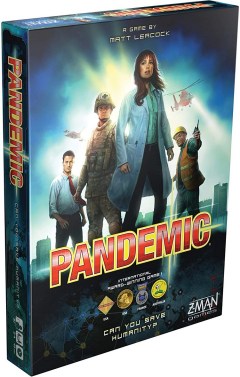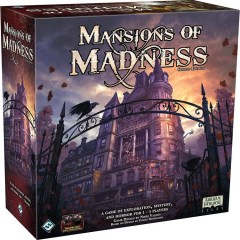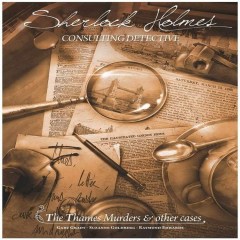BestReviews is reader-supported and may earn an affiliate commission. Details

With its educational theme and depth of strategy, this game fills an evening and can be played over and over.
With its educational theme and depth of strategy, this game fills an evening and can be played over and over.
170 bird cards featuring unique abilities. Enjoyable with 2 to 5 players. Quick turns and several different strategies to pursue. Players have a good time whether they win or lose. Components are high-quality, especially the birdhouse dice tower.
Steep learning curve for those new to modern board games.

Save the world from four deadly diseases at once in this cooperative game where everyone wins or loses together.
Save the world from four deadly diseases at once in this cooperative game where everyone wins or loses together.
Cooperative gameplay makes this well-suited to families or couples. Turns are simple, yet players are faced with difficult decisions. Good balance of strategy and random chance.
The theme may be too grim or close to home for some players.

The straightforward gameplay and exciting moments are a hit with most players.
The straightforward gameplay and exciting moments are a hit with most players.
Build trains across the United States to reach different cities. Snappy turns and tense player interaction. Good for a mix of skill levels.
Small cards are awkward to hold and shuffle.

The companion app lets players focus on gameplay as they explore the city of Arkham together.
The companion app lets players focus on gameplay as they explore the city of Arkham together.
Includes detailed plastic miniatures of horrifying creatures. App guides everyone through each scenario and makes for a thematic experience. Includes four challenging scenarios.
The length may intimidate some players.

Puts players in the heart of 19th-century London as detectives solving tough cases.
Puts players in the heart of 19th-century London as detectives solving tough cases.
A deduction and logic puzzle with 10 cases to solve. Gives you the feeling of being a detective by interviewing suspects and searching for evidence.
Once you've played all the cases, there isn't much reason to replay them.

We recommend these products based on an intensive research process that's designed to cut through the noise and find the top products in this space. Guided by experts, we spend hours looking into the factors that matter, to bring you these selections.

Maybe you’re an industry mogul developing factories—or a birdwatcher spotting rare species—or a scientist fighting off a global pandemic. Strategy games put you in these roles and more, and they come in a range of themes beyond just warfare and civilization.
While many people think of strategy board games as having dense rulebooks and intricate systems, any game that requires careful planning and keen tactical choices is a strategy game. The number of themes are limitless, and game length and complexity range widely. Some games pit players against one another; others test how well players can work together to overcome a challenge.
Finding the right strategy game for your group can give you dozens or even hundreds of evenings spent solving tricky puzzles or outwitting your friends.

Choosing a strategy board game for your family or game group means considering everyone’s favorite themes, how many players you have, and how old the players are.
Though most strategy games max out around four or five players, there are a few options with higher player counts.
A large number of games can be played with two players, and some are designed specifically for two. Though these can be tense, zero-sum competitions, they are often cozy or laid back and are popular among couples.
Three to four players is a sweet spot that almost all strategy games support. Since turns can be somewhat long and complex, a four-player cap keeps downtime to a minimum. Five-player games often play similarly, and they either mitigate downtime with shorter turns or simply embrace a slower pace.
Strategy games for six or more players are usually negotiation or social deduction games, which present an entirely different challenge. These are not for everyone, but there are few more traditional strategy games that support high player counts.
Complexity is the biggest barrier for young players. However, plenty of strategy games have only a few rules to learn.
The age range on the box is not always the best metric. Playtime can be a good indicator, as can the length of the rulebook.
Most strategy games have kid-friendly content, but some themes come with a complex history (such as games about colonialism) that may need some explaining or might not be appropriate.
For many, the theme is just as important as the rules and look. Often, these three elements combine to create an immersive and unique experience.
This is a classic theme, and there are always new entries to the genre. Colonialism and imperialism are common, but many game designers have managed to avoid these aspects of history in favor of more peaceful themes and settings. There is something about building a civilization from scratch and watching it grow that is captivating and satisfying for many people.
Arguably fueled by the bestselling Wingspan, nature games are more popular than ever and have players running zoos, building ecosystems, or even playing as different animals.
If cutting deals, making (and breaking) promises, and forming brief alliances intrigue you, negotiation games may work well for your group. For some people, these are too intense and personal, but if your family or friends don’t hold grudges, negotiation games can bring a fun social element to the table.
“No theme” is its own theme. Abstract games are often head-to-head, like Go or Mahjong. Or, they may give each player a personal board to fill in with tiles to maximize points. These are a favorite among laid-back gamers who want to enjoy a cerebral puzzle on rainy days.
Often rich in worldbuilding and vibrant illustrations, adventure games allow players to set off to unfamiliar places. You may be in the shoes of any number of characters, and modular maps or campaigns make each experience fresh and unique.
Combat-oriented games are hugely popular, with players battling monsters together or sending armies after their opponents. High production quality is common, and some games feature large plastic miniature figures that depict creatures, players, or spaceships. Most collectible card games have combat at their core.
For some, there’s nothing as satisfying as building a route of train tracks across the country to deliver goods. Transportation games range from simple and quick experiences to heavy, all-afternoon events.
Arguably the most common theme among strategy games, economic themes allow players to take the role of a farmstand owner, industry giant, or space trader – usually playing to make as much cash as possible.
Always learn how to play a game before game night. You can also set the game up ahead of time.
Even strategy games with similar themes may have vastly different play styles or lengths.
The rules and systems of a game play a major role in its overall feel and experience.
Just because a game tests players’ critical thinking or puzzle-solving skills doesn’t mean it has to be a competition.
Plenty of strategy games are cooperative, with players working together – and winning or losing together. They are often a good pick for families or couples. They can also make a nice palette cleanser after a cutthroat civilization builder. Most legacy and campaign games fall into this category.
Both campaign games and legacy games are experiences played over several sessions, but in legacy games, players will add stickers to boards, tear cards in half, and open boxes containing new components and gameplay elements.
Not all complex games are long, and not all simple games are short. Strategy games range from 20 to 240 minutes or more in length, though most fall in the 30- to 90-minute range.

Like most board games, strategy games range greatly in price, though most are well worth it if you play them regularly.
For $10 to $30, you can buy small-box card and puzzle games that offer a complete experience in a small package. Despite the size, these games may be quite challenging or complex.
Most strategy games cost from $30 to $60 and come in larger boxes with hundreds of components. Detailed illustrations are more common in this range, and many of these games support up to five or six players.
For $60 to $120 are big box experiences that often have deluxe components like a double-layer punch board, plastic miniatures, or custom dice. While these are definitely for enthusiasts, most games in this range offer an impressive amount of content in the form of campaigns, scenarios, or unique cards.
Many board game designers have their own style. If you enjoy one strategy game, look for more games by the same designer.

A. There’s no hard definition, but generally, they are games that require planning and problem-solving. They typically favor high player control over random chance.
A. If you’re playing with more than two players, every player will lose most of the time. It’s hard to change someone else’s attitude. Consider avoiding particular games or maybe even finding a different game group if the behavior is particularly disruptive.
A. There are short how-to-play videos for just about any game. Alternatively, you can find an online version of the game to play — since the game “knows” all of the rules and manages the pieces for you, you can’t break any rules, and you can learn by playing.
Get emails you’ll love.
Learn about the products you’re wondering if you should buy and get advice on using your latest purchases.
BestReviews wants to be better. Please take our 3-minute survey,
and give us feedback about your visit today.
